Saturday, January 31, 2015
Cancerous Tumors may be Reduced by CMV Treatment; The CBCD Reviews the Study
Ebola: third UK healthcare worker treated for virus
Carl Djerassi, Creator Of Birth Control Pill, Dead At 91
SAN FRANCISCO (AP) — Carl Djerassi, the chemist widely considered the father of the birth control pill, has died.
Djerrasi died of complications of cancer Friday in his San Francisco home, Stanford University spokesman Dan Stober said. He was 91.
Djerassi, a professor emeritus of chemistry at Stanford, was most famous for leading a research team in Mexico City that in 1951 developed norethindrone, a synthetic molecule that became a key component of the first birth control pill.
"The pill" as it came to be known radically transformed sexual practices and women's lives. The pill gave women more control over their fertility than they had ever had before and permanently put doctors — who previously didn't see contraceptives as part of their job — in the birth control picture.
In his book, "This Man's Pill," Djerassi said the invention also changed his life, making him more interested in how science affects society.
In 1969, he submitted a public policy article about the global implications of U.S. contraceptive research, according to the Stanford News Service. In 1970, he published another article about the feasibility of a birth control pill for men.
"The thoughts behind these two public policy articles had convinced me that politics, rather than science, would play the dominant role in shaping the future of human birth control," he wrote.
Later in life, Djerassi, a native of Austria who came to the U.S. in 1939 with his mother, wrote poems, short stories and plays. He used stock earnings from the company that made the pill to help collect Paul Klee art work, which he donated to the San Francisco Museum of Modern Art, the San Francisco Chronicle reported (http://bit.ly/16cGiZB).
"Carl Djerassi is probably the greatest chemist our department ever had," Richard N. Zare, the Marguerite Blake Wilbur Professor in Natural Science at Stanford, said in an obituary released by the university. "I know of no person in the world who combined the mastery of science with literary talent as Carl Djerassi."
"He also is the only person, to my knowledge, to receive from President Nixon the National Medal of Science and to be named on Nixon's blacklist in the same year," Zare added.
Djerassi told the Chronicle last year he was tired of talking about the pill (http://bit.ly/18DVAHK).
"Carl did many things in his life — he was a true Renaissance man and scholar," Philip Darney, a contraceptive scientist and director of the University of California, San Francisco's Bixby Center for Global Reproductive Health, told the Chronicle.
He is survived by a son, Dale Djerassi; a stepdaughter, Leah Middlebrook; and a grandson, Alexander M. Djerassi.
Proof that you CAN look great in a bikini after breast cancer: A year ago she had a mastectomy - now Sky's Jacquie Beltrao launches a new swimwear range
How To Stream The Super Bowl For Free Online In 2015
Either way, it's OK, and everything is going to be fine! It's actually super easy to watch the Super Bowl online this year. Just click over to NBC, and they'll have everything set up for you. You don’t even need proof of a cable subscription or anything.

Want to watch 10 straight hours of Super Bowl coverage in what can only be described as the modern-day equivalent of Chinese water torture? You can! NBC will start its livestream at 12 p.m. Eastern Standard Time on Sunday, Feb. 1, and will continue to stream Super Bowl coverage until around 10 p.m., when it’ll throw on a new episode “The Blacklist.” The actual Super Bowl starts around 6:30 p.m. on NBC.
This isn’t the first time NBC has streamed the Super Bowl, but it is the first time it’s been able to include the halftime show in the stream, which is good news for those of you who are forced to watch the Super Bowl but hate, you know, football.
One thing to note: The streaming service won’t work on your smartphone. But honestly, you don’t want to be that guy anyway.
'Tell us which schools have deadly asbestos in them,' calls campaign group
Gravitational waves from early universe remain elusive
Ebola: military healthcare worker returns to UK after needle injury
Vaccine Critics Turn Defensive Over Measles
Woody's RV Raffle Helps Fight Breast Cancer
Former United stars team up to tackle prostate cancer
10 Winning Recipes for the Big Game

With fork-tender chunks of beef enveloped in a deep, spicy and smoky sauce, Texas beef chili is essentially a chili-flavored beef stew. It's a world apart from the typical ground beef chili made with beans and tomatoes. GET THE RECIPE
2. Grilled Chicken Wings with Seasoned Buffalo Sauce

Classic Buffalo wings are fried but I love the flavor and ease of cooking them on the grill -- they are truly no fuss, no muss and finger lickin' good! The seasoned Buffalo sauce takes them over the top; it's made with garlic and spices, which makes it more flavorful than your typical hot sauce. GET THE RECIPE
3. Cheddar & Herb Cheese Straws
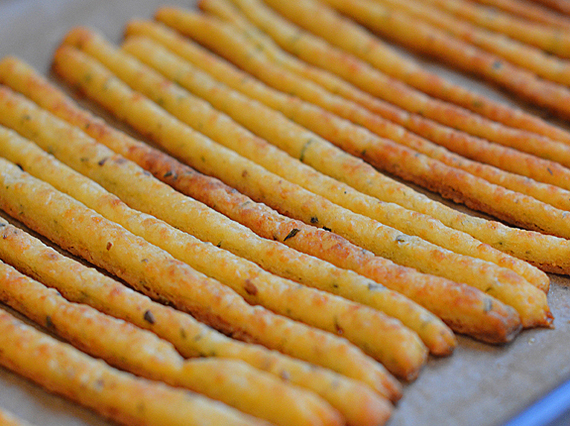
Though they look like bread sticks, these crisp and flaky cheese straws are actually more akin to savory pie crust or pastry. They are wildly addictive, and just plain fun to serve. Bet you can't eat just one. GET THE RECIPE
4. Roasted Garlic Guacamole
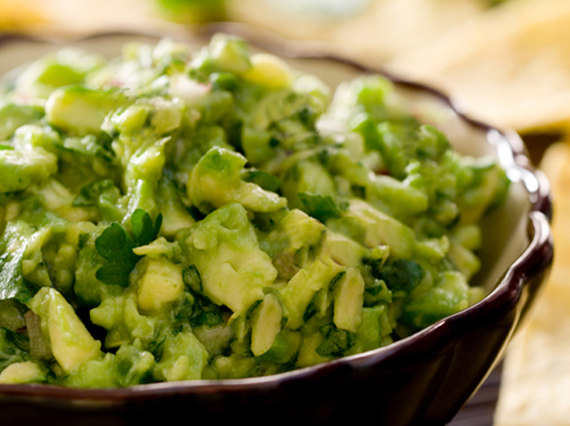
While traditional guacamole is made with raw onions, this updated version is made with roasted garlic, which has just as much flavor and none of unpleasant aftertaste. Always a crowd-pleaser! GET THE RECIPE
5. White Chicken Chili

Made with store-bought rotisserie chicken, this is an easy yet delicious chicken chili that you can prepare for your crowd in under an hour. GET THE RECIPE
6. Nigella's Party Popcorn
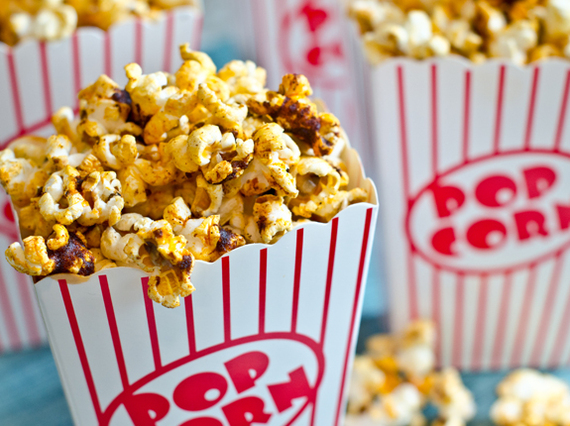
Leave it to Nigella. I used to love my popcorn topped with just a little butter and salt but now that I've had her Party Popcorn, I don't want it any other way. Slightly sweet, salty and spiced with an exotic blend of cinnamon, cumin and paprika, this stuff is downright habit-forming. GET THE RECIPE
7. Roasted Tomato Salsa

This is the best salsa: the vegetables are roasted, which intensifies the flavor of the tomatoes, mellows the onions and garlic, and adds a light touch of smokiness. You'll never go back to raw salsa again. GET THE RECIPE
8. Crack Nuts
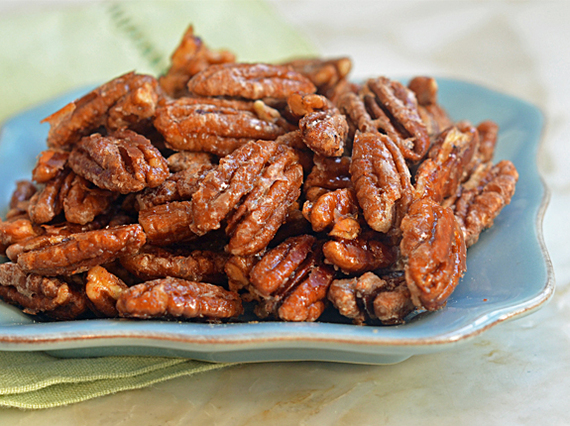
My husband calls these sweet, spicy and salty candied pecans "crack nuts" because they're madly addictive. The best part? You only need four simple ingredients to make them -- and if you start right now, you'll be done in 15 minutes. GET THE RECIPE
9. Baked Artichoke & Spinach Dip

Leave the old fashioned sour cream and mayonnaise behind: this Artichoke and Spinach dip is thickened with a Mornay sauce, which is simply a Béchamel sauce with the addition of grated cheese. It bakes up creamy, cheesy and rich, and is delicious spooned onto a baguette. GET THE RECIPE
10. Chili Con Queso
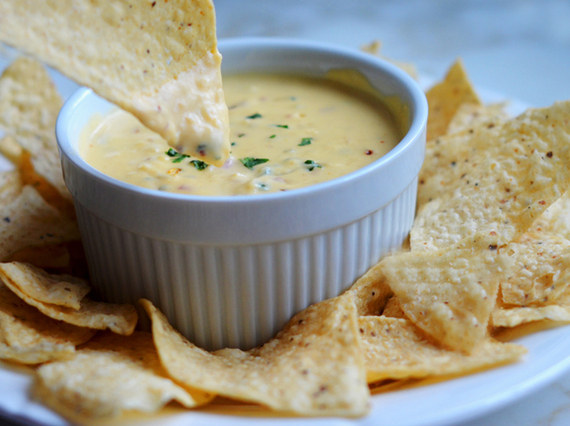
Skip the Velveeta: from-scratch queso is so much better! This version made with fresh jalapeños, Cheddar and Pepper Jack is rich, creamy and dangerously addictive served warm with tortilla chips. GET THE RECIPE
8-Year-Old Boy With Rare Brain Cancer Dies, Ethan’s Army
Moffitt researchers discover protein pathway involved in lung cancer metastasis
Moffitt Cancer Center Researchers Find Loss of Certain Protein Is Associated With Poor Prognosis in Breast, Lung Cancer
Has an 8-year-old girl found a cancer cure?
Moffitt Cancer Center Researchers Find Loss of Certain Protein Is Associated With Poor Prognosis in Breast, Lung Cancer
Asbestos violations uncovered at old federal building; project manager pleads guilty
8-Year-Old Boy With Rare Brain Cancer Dies, Ethan's Army
Breast cancer sufferer labelled a 'sick freak'
The wrong remedy for health-care costs
The Super Bowl Sprints Workout to Burn Fat and Improve Power
Working out might not be on top of your list for Sunday, but a quick morning session will start your day off with a boost of energy and keep your metabolism working as efficiently as possible well into the evening. This workout can be done on a football field to get you in the mood!

https://www.youtube.com/watch?v=AOZ1vrla7iY&feature=youtu.be
For additional workouts, recipes and more please follow me on Twitter http://twitter.com/noratobin and checkout my blog http://noratobin.com
Have a great Super Bowl!
Friday, January 30, 2015
Heat Up Your Intimacy by Cooking Together
Creating a romantic menu can be a bit tricky so I have added some easy tips to keep your mojo moving and make it a meal you can savor.
(1) Don't over-shoot. This is Valentine's Day, not a last meal, so keep it elegant and light. No one wants second dessert after a heavy stew or a reminder of Mom's homemade meals. Seafood is by far my choice ingredient -- simple, different and with a bit of sex appeal. Try out a tuna tartar or some simple chilled shrimp cocktail. Keep in mind that if you're doing a three-course menu, which I hope you are, you can play with temperatures and textures; if you're having a warm entrée start with a cold appetizer.
(2) Heat it up. Choosing products that can handle high heat will speed up your cooking process and get you out of the kitchen and enjoying your menu before you know it. For example, choosing an entrée like lamb chops or filet mignon are excellent options because they require a short cooking time and are succulent. Pair them with couscous, another time saver, and you're headed to dessert before you can lick your fingers.
(3) It takes two to tango. The kitchen should be an area where both of you are doing work and enjoying the spoils. For dessert I suggest fondue. It's simple and elegant and it takes a light touch -- get him on chopping duty while you master the chocolate stirring.
With just a little rhythm in the kitchen you can make this Valentine's Day the juiciest and most tender ever.
Fluorescent dyes ‘light up’ brain cancer cells
Ancient deformation of the lithosphere revealed in Eastern China
Breast cancer sufferer branded a 'sick freak' for wearing booby hat in supermarket
A Protein-Packed Salsa Recipe You've Got To Try (VIDEO)
White Bean Tomato Salsa
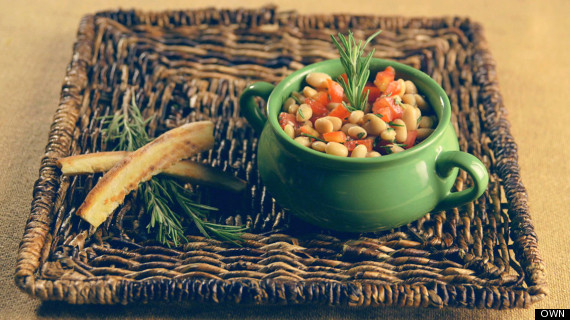
Serves 4
Ingredients
2 Tbsp. extra virgin olive oil
2 tsp. fresh rosemary, chopped
1 plum tomato, chopped
1/2 tsp. salt
15 oz. white beans (1 can), drained and rinsed
Grated Parmesan, to taste (optional)
Directions
In a medium bowl, combine the white beans, rosemary, tomato, olive oil and salt. Sprinkle with grated Parmesan, if using.
Serve with healthy, homemade pita chips.
 Like Us On Facebook |
Like Us On Facebook |  Follow Us On Twitter
Follow Us On TwitterCarolinas HealthCare asks court to block Fort Mill hospital construction
Fluorescent dyes 'light up' brain cancer cells, reports Neurosurgery Wolters Kluwer Health
Homemade Ranch Mix Is A Revelation For Dressing Lovers
We will always have a soft spot for store-bought ranch -- Marie's in particular -- but as always, homemade is so much tastier. When it comes to ranch, homemade means you can actually taste the buttermilk and herbs. And you can adjust it to your liking. Problem is, not all of us always have these fresh ingredients at the ready. Stephie, from the food blog Stephie Cooks, has a great solution for this problem: Homemade Ranch Dressing Mix that'll stay good in your pantry.
Making your own ranch mix at home means that you'll not only have the superior taste of homemade ranch but you'll also be able to have it whenever you want. Plus, this opens up the possibility of making ANYTHING you cook taste like ranch. Dip? Of course. Burgers? Sure. Cookies? Have at it. Plus, all the dressing you could ever hope for.
Get the recipe here and drown your life in ranch.
Want to read more from HuffPost Taste? Follow us on Twitter, Facebook, Pinterest and Tumblr.
New hope for lung cancer victims
How should health-care workers decide which patients get organ transplants?
5 Reasons I Wish We Would Stop Talking About 'Recovery' for Serious Mental Illness And the Word I Wish We Would Use Instead
There's a popular quote floating around mental health advocacy circles: "Mental illness is not a choice. But recovery is." I know people will disagree with me, but today, I'm tired of that sentiment, and I wish we would retire the word "recovery." When local and national mental health policy is shaped by high-functioning consumers who have been able to manage their illnesses rather than by the sickest patients and their families, it's the equivalent of only allowing stage 1 cancer survivors to drive the narrative and take most of the funds. While their courage is admirable and their struggles are genuine, too often, we lose sight of those who are suffering the most. They become invisible to us, marginalized on the streets or in prison. Or they die young, like Zac.
I wish we would stop talking about recovery and replace it with a more useful, less stigmatizing word: hope.
Here are five reasons I wish we would stop using the word "recovery" for serious mental illness.
1. Not everyone recovers. The word "recovery" has become central to mental health care, from the top down. In fact, the Substance Abuse and Mental Health Services Administration's stated mission is that "People recover." With serious mental illness, that's not true. People recover from head colds. They recover from chicken pox. They recover from situational depression. They even recover from trauma. But some diseases are lifelong. Like diabetes, or Parkinson's disease, or multiple sclerosis, serious mental illness is a lifelong, chronic health condition.
2. Recovery and its partner phrase, behavioral health, imply that mental illness is a choice. Mental illness is not a choice or a character flaw. The focus on "behavioral health" unintentionally stigmatizes the very people that SAMHSA is meant to help: those with serious mental illness.
3. The word "recovery" suggests that people need to return to a "normal" state, rather than embrace their differences. What does a person with bipolar disorder or autism need to "recover" from? When people realize they are not their diagnoses, they can start to find things that actually work to help them live successful and productive lives. That's hope, not recovery.
4. The concept of recovery increases stigma, both within and outside the mental health community. Again, if people recover, why aren't you recovering? It must be a choice you are making, or something you're doing wrong. Some people tell you the medications you take are preventing you from recovery. Others tell you that your choice to stop medication is preventing you from recovery. Who is right? Hope is a universal concept that embraces a wide range of possibilities. Recovery seems dependent on a prescribed set of treatments that may not work for everyone.
5. Recovery is an unrealistic standard for any chronic illness, including mental illness. We would never apply the blanket expectation of recovery to any other chronic illness or disability. With cancer and autoimmune disorders, we use the term "remission" to describe a life-threatening systemic illness that with luck and treatment has been stopped in its tracks. With other chronic illnesses like diabetes, we talk about managing the illness. But with mental illness, we expect people to "choose" recovery, even when they are experiencing psychosis, or when their disease steals their ability to make rational choices.
Behavioral health is an important concept for everyone. We should all focus on our behavioral health: on diet, exercise, mindfulness, good sleep habits. But behavioral health is not mental illness. Mental illness is physical illness. For people with serious mental illness, behavioral health alone will not "fix" or "cure" the chronic condition, and for us to expect otherwise is unrealistic and cruel. We need to focus on effective treatments, not inaccurate judgments about what we "believe" or "feel" mental illness is. It's a very real health challenge, with real and sometimes devastating consequences for those who live with it and their families.
Let's keep talking about behavioral health for everyone. But let's stop talking about recovery for serious mental illness and start celebrating people whose brain disorders cause them to live with health challenges comparable to those experienced by cancer patients. The word we need, in the face of so much loss, is hope. Mental illness is not a choice. But hope is. Even in the face of tragedy, today I choose hope.
CDX-011 Shows Promise in Advanced Breast Cancer Ailment
A Revolutionary Entrepreneur On Happiness, Money, And Raising A Supermodel
If all goes well, Robin Chase may get to do it twice.
A decade before Airbnb and Uber, Chase helped kickstart the "collaborative economy" by co-founding Zipcar, which became the world's largest car-sharing service. The big idea was to replace the enable convenient access to a valuable good (in this case, a vehicle) without requiring ownership.
 Now Chase and others have founded Veniam. Their technology powers mesh networks, which provide a new way for people and things (devices, cars, appliances, etc.) to connect to each other and to the internet. The holy grail: ubiquitous no-cost wireless internet access that isn't controlled by the telecom giants.
Now Chase and others have founded Veniam. Their technology powers mesh networks, which provide a new way for people and things (devices, cars, appliances, etc.) to connect to each other and to the internet. The holy grail: ubiquitous no-cost wireless internet access that isn't controlled by the telecom giants.Fred Wilson, one of the most influential and successful technology venture capitalists of the last decade, announced last month that his firm has invested in Veniam. "We are consciously trying to see the future and seed the future," he wrote.
Chase's story is colorful. She was raised in the Arab world, the daughter of an American diplomat. She is the mother of three children, including one world-famous supermodel. And her career has seen lows as well as highs. "I was a complete shell," she says of one tumultuous period. "It took me, honestly, probably a year to recover."
I spoke with Chase for Sophia, a HuffPost project to collect life lessons from fascinating people. She shared practical wisdom about relationships, raising kids, finding happiness, how she approaches aging, and her latest thinking about the collaborative economy.
Have you had any recent realizations about living a more fulfilling life?
I attribute a lot of what I have to dumb luck. I've made sure that my family and my children have understood that reality strongly. Being a white well-educated American who doesn't have any immediate family in distress -- that was just like a birthright. What a lucky thing.
My father was an American diplomat. I grew up in the Arab world. I feel that Americans, in particular, lack an appreciation for how incredibly lucky the circumstances of their birth are.

Did you try to foster that in some way with your own children?
There's this story that lives in infamy. We're sitting around the dining room table. My eldest daughter says, "I got straight A's this semester," filled with glee, making her younger siblings feel bad. I said to her, "You know, I'm not so impressed. You're no Maya Angelou."
I said, "There's three things in life. You were born with the genes that you have through sheer luck. It had nothing to do with you; you can't take any credit for that. Your environment is also dumb luck. You happened to be born to parents who believe in education. You have this great environment. You don't get any credit for that. But you do get credit for working incredibly hard. So good for you. You worked incredibly hard. None of those other things you can get credit for."
She fell out of her chair onto the dining room floor, laughing. She said all her peers were getting paid like $20 for each A-grade, and her mom is saying, "Well, an A is okay, but you're not getting a lot of credit for that."
So I absolutely did pound into them where our values lay and what they got credit for.
Below, Chase's daughter Cameron Russell delivers a TED talk in which she discusses winning the "genetic lottery."
You have said, “I’ve never been motivated by money.”
I have always lived my life in such a way that I feel like I'm not taking more than my fair share.
Everyone should be able to live the way I live. So you know, I have not bought my private jet [laughter]. I went to the Goodwill the other week and I got a spectacular silk designer dress that I was really happy with.
I'm still leading a low-consumption, low-footprint life. I think this goes back to, as my father taught me, that I am really an equal. I am an equal. It's profoundly embedded in who I am.
I live in Cambridge, Massachusetts, in a very dense urban environment, mixed-income environment. Years ago, it was summertime, I have these three kids, I’m working, so I’m putting them into different activities.
For a while, I was feeling extreme angst. ‘Wow, my kids are so incredibly privileged. They're getting to go to the day farm camp, or they're getting to go to the Audubon habitat.’ And I was running through my head, ‘Are they getting too much privilege? Are they going to become spoiled brats?’
Then I thought, no, no. The standard that I should exercise here is, I think every child should get to have those things. I wanted to give my children what you would want for every child.
Putting genetics aside, is there anything you've done as a parent that you feel had a lasting impact on your children?
As I raised my children, I really wanted to impart that their happiness would revolve around family and relationships and maybe travel, and not around consumption, so that when they moved into adulthood, they could choose a much broader array of career potentialities. They could be a starving artist and be completely happy because their happiness was not stemming from some income stream.
My children do tease me that there were never any electronic toys in the house. There were no battery toys in the house. For a long, long time, the dress-up box and the pile of old FedEx boxes was the thing.
They will tell you, they led really happy childhoods. They are really pleased with their childhood. When they would say, "How come everyone else was getting these things, and we don't have these things?" I'd say, "You know, I take you on a nice trip sometimes.”
That's where my value is. Stuff is not -- I'm not interested in that. I don't want to have stuff.
You left Zipcar after a period of intense work and fundraising, and shortly afterwards, your father passed away and your daughter’s modeling career took off. What changes did you make to your life after that period?
I am a person who works all the time and whose life is their work. I try to make the barrier between work and life -- actually, I don't have a strong barrier, because I really want to be working on things that I care about. By some measures, I am working all the time.
Post-Zipcar, I definitely was a complete shell. It took me, honestly, probably a year to recover. And then I promptly started working those same long hours.
A luxury of my life is that I've been able, with my spouse, to switch back and forth many times who is the primary breadwinner and who is the primary caretaker.
Whether or not I was doing one role or the other, I was still actively working on intellectual and other pursuits. And as my children have aged, whether I'm getting paid or unpaid, I'm still doing the same work.
Let me add this. It took me a long time to figure out who I am. Post-Zipcar, I've increasingly figured out that my best strengths are ones that I had never appreciated or really understood.
Now, as I've moved forward, I think I have a much better handle on that. I think I'm a good learner. And I'm learning a huge amount in lots of different disciplines. And then, being able to synthesize or seek connections across those fields to see larger patterns and make them feel simple.
To do that requires active listening. There's this recursive piece where you are getting feedback from your environment as well as having your own ideas. You're pushing a little bit in the direction that you think is the right direction. And you're listening very carefully to what the feedback is on that. I think that is how we built Zipcar. And I think that is how I've been developing these ideas and this trajectory that I'm on.
I talk to a whole bunch of people. I listen to how those words fall, and their reactions and their experiences. That shapes how either I should be thinking or how I should be talking about it. It's this constant, delicate learning and pushing path. It's a funny -- it's a very active and directed listening.
What is your latest thinking about how technology is changing our economic models?
I have just finished writing a book. It’s called “Peers Inc.,” and the subtitle is “How People and Platforms are Inventing the Collaborative Economy and Reinventing Capitalism.” I'm totally psyched.
There is a new organizational paradigm that is happening. It is actively transforming how we build businesses, how we work and how we create economies.
If we think about crowd sourcing, Web 2.0, all that stuff, people are empowered. And many say this is “because of the internet.”
That lacks specificity. Actually what's happening is we're leveraging excess capacity, building platforms for participation that organize and simplify the work of these collaborating peers.
We have this new, deep collaboration that's very resource-efficient -- ‘resource’ meaning people, money, assets, networks -- where companies or governments or institutions are doing only what they do best.
This is because transaction costs have now lowered. Dealing with many small parts is no longer an irritating thing. You don't have to bring it internal. And the “peers” in a peer economy -- which can be people or devices -- are each doing what they do best.
@veniamworks founded by @rmchase turn buses into Wi-Fi hotspots http://t.co/V6cSfsPcbE
— Rad Campaign (@RadCampaign) January 25, 2015So we have this new collaboration that's incredibly powerful and has speed, scale, a high pace of innovation, and adaptability. This organizational paradigm matches our times. The global economy is moving at a very high pace of change. And this structure enables you to iterate and experiment, adapt and evolve, really quickly to match that pace.
It also changes the power structure. If you think about capitalism, it was based on scarcity and hoarding of assets, like trademarks, intellectual copyrights, secrets. This new economy is saying, actually, open shared assets deliver way more value than the old way. It is a fact.
It's kind of the end-run for the Internet. The Internet was created 40 or 45 years ago. But we've really been working with it for about 25 years. Now it's kind of come of age. We're able to figure out, what are its powers? How do we use it?
The collaborative economy is larger than the sharing economy. The sharing economy feels to me like it's about assets. The collaborative economy is everything. It’s making clear and visceral to us that, if I can have real-time access not just to hard assets, but to people, to networks, to experiences, it means that the way I do my own personal life is completely transformed. I don't have to do any hoarding.
I don't have to be worried about having stuff and owning it. I can start to rely on the fact that I can reach out and find the right person at the right moment. That dramatically transforms how you live. Instead of on-demand cars, it's an on-demand life, in a much larger fullness.
It really shapes our potentiality and the pace at which we can do that.

What books have had a profound influence on your life or intellectual development?
One was “Guns, Germs, and Steel” by Jared Diamond. It’s a book that I loved for years and years. After I read it, I bought 10 copies and gave them to different people. That’s the only time I ever did that.
The book comes back to this idea, what is the dumb luck that you're handed? The thesis is: where biology and geography intersect became our destiny. I found it totally fascinating.
More recently, there are a bunch of thinkers over these last 10 years who are either researching or implementing or writing variations on this incredible economic transition that we're in.
There are people like Yochai Benkler and “The Wealth of Networks.” Jeremy Rifkin, Chris Anderson of Wired and I share a lot of ideas. Tim O'Reilly, Lisa Gansky. There’s a whole group of thinkers and doers that are all moving in this same direction, seeing what the underpinnings are, what the new tools are, what the implications of those new tools are.
How do you sleep?
Terribly, because my mind does not shut down. I can fall asleep, and then the second I come out at all, it snaps on. I start thinking about 10 different things, can't get back to sleep. That's how I sleep.
Do you have any advice regarding relationships?
The person that you happen to choose as your spouse is so incredibly important. I think women in particular are enablers of bad behavior.
They're finding a partner when they're between, say, the ages of 22 and 30. There's some shaping potential to be done. And yet, they don't demand their partners take a 50 percent share in household duties, child-rearing, cooking, whatever it is. So the enabling starts. Then they work themselves into a corner.
I was giving a talk the other day to all these veterans who are entrepreneurs. They were 92 percent male. As I was talking, it suddenly occurred to me that, when men also don't learn how to be competent at child-rearing and these other activities, they are covertly telling their spouse -- who is supposed to be the person they love the most -- "You know what? I'm going to be hobbling your career potential because I'm going to be unskilled and useless."
I feel like it's a value judgment. I want to put the burden also on those men. When they are incompetent or unwilling, they are saying our professional futures are not equal.
How did you adjust your marriage after children?
The world is divided into two groups: people who have children and people who don't. It is night and day, having children and not having children. I think of children as “human objects” until the age of like 14 [laughs], i.e., 24 hours a day, every second, you are responsible for them.
The way I'm living now [no longer with young children], every morning I wake up and think -- how incredible! I can lie in this bed, or I can get up! I can change my mind! I can leave the house. I can make appointments. I can travel.
When you are with children, that is all locked down. The freedom of your life is just dramatically different. I certainly did not appreciate it. And when I had my first child, I thought, whoa. No one clued me in on what a giant hit having this child is on my personal autonomy, which impacts my ambition in life, professional potential, and so on. It is a giant hit.
Is there a particular reason you chose to have three children?
Greed. [laughter] I used to work in public health. I was allowed my 2.2 children. Then I hid my third pregnancy for as long as I could because I thought, my god, this is greedy. This is antisocial. This is a total embarrassment. Yeah.
Also, I'm laughing about three children. My husband was less for it than I. I thought, two children is just so easy. [laughter] Life is so pat, you know. Two in front, two in back! It's one adult, one child; it's so simple. Let's shake things up here. So that was also why I had a third child. To make life more akilter.

Have you taken any travel journeys that you would recommend to others?
A really instructive thing is to have Americans understand what a totally different economy and different GDP look like on the ground, living it. We've done a number of vacations where it's been this six-dollar-a-night type of place, a treehouse, a cruddy place in the corner.
My son had this great line. He said, "Wow, people can be really happy without money." And I just thought, yes. Bingo. Let's get that.
It comes back to this privileged life. I want to say 90 percent of the time, when I step into my warm shower, I'm thinking, how incredible. I am standing here, and there's this running water, and it is warm. What an amazing thing.
I honestly think about it almost every time I take a shower. Or wow, I'm lying down on a flat bed, and these sheets are so clean. I'm appreciating that all the time.
How are you approaching aging?
What's curious is around age 52, I suddenly started to think about old age. I had never ever thought about it at all. You never picture yourself there. And suddenly, at this really late age, I thought, wow. My eyesight is declining, my knees creak.
I’ve realized that there's a whole bunch of women in their 70s that are really fabulous. And I thought, I'd like to be one of those really fabulous women in their 70s. But in order to be a fabulous woman in your 70s, it means that I have to be intellectually astute and up and active and engaged now.
Is there anything else you wanted to discuss?
Yes. Addressing climate change. Let's get with the program. Right now, this very moment that we're sitting here, it's either we make dramatic changes or we're moving into a catastrophic world.
It's not your grandchildren. It’s 20 years. In 20 years, it's going to be a really sucky world out there. The reality is so extreme that my saying this makes people think, “You can't trust Robin because she's gone out of her mind.”
It is honestly a crazy reality. It is catastrophic. We're seeing institutions one by one acknowledge it -- the World Bank, the U.N., the IPCC and Obama -- but it’s couched in these little careful terms.
As we're sitting here, the highest likelihood is that we will go to between plus-7 degrees Fahrenheit and plus-10 degrees Fahrenheit global climate change by 2100. What in the heck does that mean?
Minus-7 degrees Fahrenheit was the last Ice Age 50 million years ago. Humans did not exist. And Boston and New York and most of North America was under one kilometer of ice.
So we went from one kilometer of ice, 50 million years ago, no humans -- we are going to that amount of change in 85 years.
#marchwithme at the @peoplesclimate march starting tomorrow at 1130am Columbus Circle NYC
A photo posted by @rmchase on
That's what we're doing right this second. Even 40 years out is looking pretty rotten. And that's if we do the things that we promised to do. If we don't do those things, which is exceptionally likely, it's in 20 years. It is not some distant thing, and it is not some small amount. This is ecosystem collapse.
So one of the things I think about Zipcar is that people realized, sharing resources leads to a better world. I have a better quality of life. I save money. And it actually has this dramatically strong environmental underpinning. So we can go there proactively, making it as best as we can, or not.
I think you do go through these seven stages of acceptance. And I think people are, right now, all around in the giant denial. If they aren't in a giant denial, they're in the pissed off phase. And we have to move through that and get to -- let's get going. Let's do it.
Transcription services by Tigerfish; now offering transcripts in two-hours guaranteed. Interview text has been edited and condensed.

Sophia is a project to collect life lessons from fascinating people. Learn more or sign up to receive lessons for living directly via Facebook or our email newsletter.
Here's more from Sophia:
- He Asked 1500+ Elders For Advice On Living And Loving. Here's What They Told Him.
- Life Tips From The Ph.D. Who's Discovering How Meditation Changes Your Brain
- Watching Rainn Wilson Talk About Happiness Will Make You Happier
Remember Red Pistachios? Here's What Happened To Them
Pistachios are native to the Middle East and Asia, and up until the 1970s, the United States imported most of its pistachio nuts. Though pistachio trees were first planted in California in the late 1800s, the industry didn't take off in America until the country enforced an embargo on Iranian pistachios in 1979 due to the Iran hostage crisis. While the ban was lifted in 1981, it was enforced again from 1987 to 2000, and then reinstated by President Obama in 2011 in response to Iran's nuclear program.
Today the United States is the second largest producer of pistachios -- after Iran -- and around 98 percent of pistachios grown in the United States come from California. The rest of the country's commercial pistachio production occurs in Texas, New Mexico and Arizona.
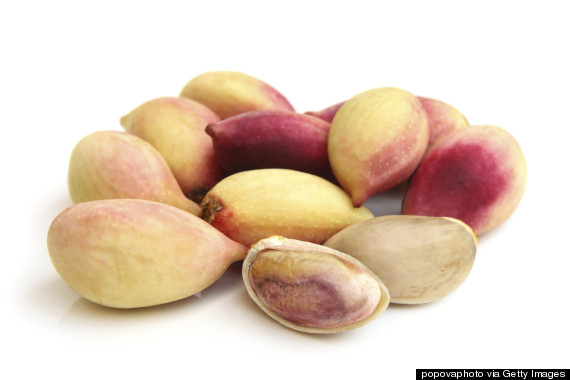
The disappearance of red-colored pistachios is a direct result of the exponential increase in homegrown pistachios and the limit on pistachio imports from the Middle East. When the U.S. was importing pistachios, the nut shells would often be splotchy in color, the Kitchn Explains. They got stained from traditional harvesting methods in which the nuts weren't immediately hulled and washed. Since the appearance of these stains was unappetizing, pistachio producers in the Middle East took to dying the shells bright red to hide the stains, Richard Matoian, Executive Director of the American Pistachio Growers told HuffPost Taste. A few American producers followed suit because the market was used to seeing pistachios with a bright red hue, Matoian said. But all that's over now.
Red pistachios starting disappearing in the '80s, Matoian confirmed. With the limit on imports and the increase of American grown nuts with American harvesting systems, there became no need to dye the nuts. American pistachio producers use a harvesting system that drys and hulls the nuts before they are able to get stained, which eliminates the need for covering up blemishes altogether. Even today in Iran, Matoian explained, pistachio producers have picked up the new harvesting technique that eliminates stains and the subsequent need for dye.
You can still find red pistachios in some places, Matoian told HuffPost Taste, but they're just a rare novelty product and a seasonal one at Christmastime, not the dominant trend they once were.
The upshot of red pistachios being all but obsolete today thanks to California-produced pistachios is that you no longer have to worry about dyed hands -- an unfortunate result of the red dye. Pistachios are just a little more boring now.
Want to read more from HuffPost Taste? Follow us on Twitter, Facebook, Pinterest and Tumblr.
Addressing pitfalls of health-care cost transfers
Effectiveness of Radiotherapy for Mesothelioma Patients After Surgery
Former City manager Stuart Pearce: 'My fears of asbestos exposure while working as an electrician'
Sarris Candies Makes Deflated Chocolate Football
The (Washington) Observer-Reporter (http://bit.ly/1wzxQsz ) reports that Bill Sarris had his Canonsburg staff make a chocolate football with a big dent in the side. It's not for sale, but he posted it on Facebook as a joke.
It's named the Bradie ball. That's B-R-A-D-I-E to avoid any legal issues.
The picture's caption says, "Net weight 13 lbs ... Oops! We meant 11.2 lbs."
The Patriots and quarterback Tom Brady have been accused of using underinflated footballs in the AFC Championship game. They play Sunday in the Super Bowl.
Sarris won't explain how the chocolate got its deflated appearance.
He says only, "You'll have to ask the Patriots how they did it."
Vietnam hesitates to ban white asbestos use
Molecule could hold key to breast cancer cure
Eyeing On Quality Healthcare Service
Woman finds poetry in her battle with brain cancer
Valeant to buy Dendreon's prostate cancer vaccine Provenge
Woman finds poetry in her battle with brain cancer
Dealing With the Fear of Cancer
So when that c-word is directed at you, those unknowns become magnified. Have those scientific achievements reached your particular diagnosis? And even if they did, what must you endure to reach that stage of remission? If told there is no cure for your cancer and chances are it will revisit you, you must learn to adjust all over again, to a different way of life. This task may not be as formidable as you might think. In fact, the challenges it presents can add a whole new dimension to your life and present a perspective to your view of reality that you otherwise may never have experienced or imagined.
For many, the best way to deal with fear is to face it and determine exactly what it is you fear. Some of the most common fears and tips to deal with them are as follows:
1. Knowledge is power.
The best way to face the fear of your diagnosis is to ask your physician as many questions as possible. Will you need an operation or will you be treated with medication? You will want to know the stage of your cancer and, if it's defined more specifically than stage, like grade and degree of aggressiveness, ask for those details as well. Cancers vary in their description. Some are broken down strictly into stages, usually from stage I to IV. Others have a grade associated with them, i.e., a, b or c. Others have further classifications. You'll want your physician to provide you with all of the details of your specific cancer.
Knowing which category your cancer falls into will give you an idea of how serious it is. For instance, stage I is usually the stage at which the cancer is detected very early and can most likely be treated easily. Once treated, the cancer has a less likely chance of returning. Stage 4 cancers on the other hand, are late stage and the tumors have most likely grown to a significant size and/or metastasized to organs in the body apart from the original growth site. Yet, they too can lie dormant or go into remission for many, many years. Remember, information is power.
2. Managing the side effects of chemotherapy.
While years ago chemotherapy was considered very difficult to endure, there have been significant developments as far as managing the side effects of chemotherapy are concerned. Side effects will vary depending on the person and the kind of chemotherapy being administered. There really is no one size fits all answer but chances are likely that your side effects will be minimal. The best way to cope with chemo is to ask your doctor about the treatment plan and what side effects to expect. If told there will be some, find out exactly what they will be or could be and prepare accordingly. Usually, most side effects are temporary. Nausea and vomiting are the most common. However, oncologists now administer anti-nausea drugs right along with chemotherapy and those usually control the issue. Nevertheless, there may be times you occasionally experience nausea and/or vomiting. If you prepare ahead of time for either additional medication or other natural remedies to take, you can help to minimize those experiences.
3. Dealing with hair loss.
This is often a huge issue, especially for women. Some treatments are more prone to hair loss than others. If you're told this is something to expect, there are a number of things you can do. Women with long hair may want to cut it short so the loss won't be as drastic when it happens. You may also want to shop for wigs beforehand if you don't like the idea of being hairless. Using head scarfs is another option and they can be tied in a number of fashionable styles and serve as a great alternative to wigs. Doing these things ahead of time help to prepare you mentally to adjust to your new appearance once the hair loss occurs. It's also easier to accept once you understand the loss will be temporary.
4. Remaining Independent.
Since everyone's cancer is different, your ability to remain completely independent will vary. A lot will depend on the aggressiveness of your cancer and a host of other factors. Your diet, your frame of mind, your ability and willingness to exercise will all play a significant role in retaining your independence. Many people live with late stage cancer and do so quite independently. Regarding your cancer as something that's happening to you, not as something that defines you can help tremendously. If you adopt an attitude that you plan to move through this challenge by addressing each obstacle as you're confronted with it and not be overwhelmed by it, you increase your chances for quality living.
5. Overcoming the fear of death.
This is often the initial thought one has when diagnosed with an incurable cancer. Yet, it's often suppressed, lingering there in the recesses of your mind. It's much healthier to acknowledge the fear and address it. The fact is, new advances are being made with cancer all the time. In addition to traditional advancements, there are a plethora of alternatives that, while not as well researched, offer much promise. Even chronic, incurable cancers are often put on hold for an indeterminate amount of time.
Fear of dying is a natural feeling. The best antidote is to reframe your thinking to focus on living the best life possible and maximizing your time here on earth. Who knows, with a new awareness of life, a new attitude, and new lust for living, you may very well add even more years than you imagined. If nothing else, you made your time here on earth something to enjoy and love. Coping with fear is all about empowerment. It's important to ask questions, to live in the moment - seeking fulfillment in all that your do and minimize stress and resentment. It's also important to understand no one knows when their time to cross over will come. So, living in the moment and living with purpose is powerful.
Do you have a story about cancer and emotional wellness you'd like to share? Email us at healthyliving@huffingtonpost.com to share your thoughts in your own words. Please be sure to include your name and phone number.
Building trustworthy big data algorithms
Thursday, January 29, 2015
Cranberry Coconut Energy Bites
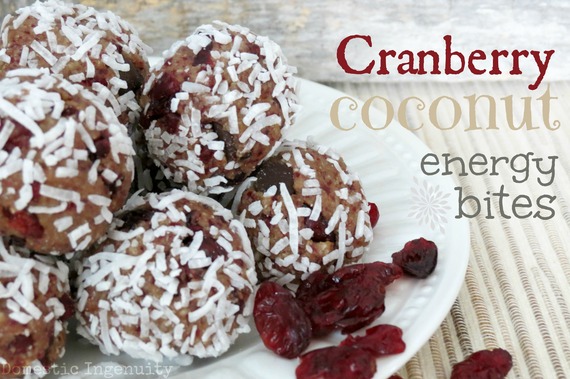
As a mom chasing after a very busy toddler, I find it a challenge to eat well-balanced meals and snacks all the time. When I'm running out the door or heading for an afternoon walk I want a quick snack that's balanced with protein, carbs and healthy fats. I get tired of making protein shakes and I just need something quick to grab on the go! I wanted to incorporate my plant-based protein powder into a snack recipe. After trying several different recipes, I combined my favorite ingredients from a few and they turned out perfect! The best part of these bites are that they are grain-free, gluten-free, high in protein, and high in omega 3's. By no means am I paleo, gluten-free or grain-free... heck, these days I just try to stay French fry- and ice cream-free.
Ingredients
3/4 cup mixed nuts (I used an unsalted mixed nuts blend)
1/4 cup pitted dates
1/4 cup vanilla protein powder
1/2 cup dried cranberries (or other dried fruit of your choice)
1/4 cup shredded unsweetened coconut
1/2 tsp vanilla extract
1/2 tsp almond extract
3 Tbsp organic peanut butter (or almond butter)
1 Tbsp pure organic maple syrup
1/4 cup dried cranberries, coarsely chopped
1/4 cup chocolate chips (optional)
1/4 cup shredded coconut for rolling (optional)
Directions
1.Place the mixed nuts, dates and protein powder in a food processor. Mix until finely chopped and combined (30-45 seconds).
2.Add the rest of the ingredients (except ¼ cup dried cranberries and chocolate chips) to the food processor. Process until a dough ball starts to loosely form. (This takes a minute or two.)
3.Transfer the mixture to a large bowl and add the remaining coarsely chopped dried cranberries and chocolate chips.
4. Roll into balls, then roll into coconut and store in an airtight container in the refrigerator or freezer.
They are super quick an easy to make, don't require mixing wet and dry ingredients, no need for your oven and mixed all in one bowl! I loved the texture of these and the fact that they eat like a dessert! Have a great weekend!
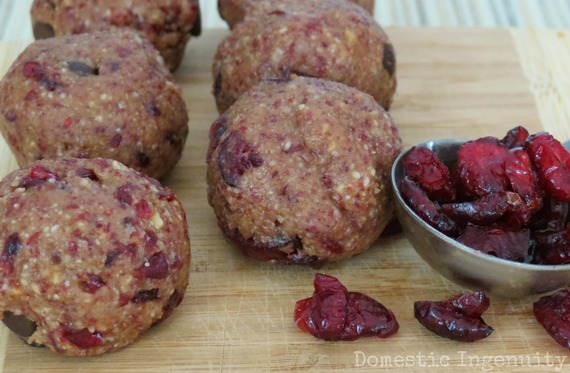
Cheerfulness is the best promoter of health and is as friendly to the mind as to the body. ~ Joseph Addison
Learning From My Ruler

Robert Fulgham once wrote a wonderful book, Everything I Ever Needed to Know I Learned in Kindergarten... I think for me it was in grade school... and it was on this ruler, passed out to all children in schools throughout the state by the Coca-Cola Bottling Company.
I ran across one the other day, cleaning some things out at my mom's house during her recent move. On the other side of this ruler is a lesson in getting along... in understanding, in knowing how we should conduct ourselves. Just below all the numbers, all the hash marks was the Golden Rule: Do Unto Others As You Would Have Them Do Unto You.
It's interesting when you dissect it down and look at it from the end first. You. Rather than put it into You being the bigger person, You becomes the one that is Done Upon. And as the one who is Done Upon, it makes you look at things a little differently... rather than being the magnanimous one who is doing it, it makes you look and see how others actions affect You... and when you do that, suddenly the real meaning becomes pretty clear. If You don't want it done unto You, then don't do it to others.
The nice thing is that this cuts across all lines... no matter what your religion, what your color, what your life is like, who You love.... You have to decide how it would feel to have it being done unto You.
Going back, the real lesson here is empathy. And if we can figure that part out, as we were taught by a simple elementary school tool, then we have the only thing we need to know... and I learned that in grade school... with a simple ruler.
Testing for EGFR mutations and ALK rearrangements is cost-effective in NSCLC. International Association for the Study of Lung Cancer
Market Report, "Slovakia Pharmaceuticals & Healthcare Report Q1 2015", Published
New Imaging Tech Nearly Quadruples Breast Cancer Detection In Dense Tissue
Is this the year you join the top one percent? Affluence more fluid than once thought
Criminal asbestos case against Tennessee salvage company
Mesothelioma Compensation Center Answers the Important Question of What "Probate" is and Urges Diagnosed Victims to Call for the Nation's Best Compensation Lawyers
5 Sexy Steak Wines
Piccini 2008 Riserva Brunello di Montalcino DOCG
Montalcino, Italy
For over 125 years, Piccini has been making some of Italy's finest wine. Their 2008 Brunello Riserva DOCG is a ripe, fruity wine, ruby red in color with a bouquet of black cherry and spice. It offers ripe fruit across the palate with hints of cherry.
Suggested Cut: This wine's mouthwatering acidity pairs well with big, beefy steaks like porterhouse.
Read a complete review of Piccini 2008 Riserva Brunello di Montalcino DOCG
Seghesio Family Vineyards 2011 Rockpile Zinfandel
Sonoma County, California
Seghesio Family Vineyards first began producing wine in Sonoma County in 1895, nine years after Edoardo Seghesio left his family's Piedmont, Italy, vineyards in search of a new life in America. The well-balanced 2011 Rockpile Zinfandel displays notes of red fruit and spice on the nose, with robust flavors of candied apple and currant on the palate.
Suggested Cut: This spicy Zin is an ideal counterpart to a juicy strip steak. Fries on the side, please.
Read a complete review of Seghesio Family Vineyards 2011 Rockpile Zinfandel
Recuerdo Wines 2011 Aliado Malbec
Mendoza, Argentina
In Spanish, "recuerdo" means memory or to remember, and winemakers Santiago Achával and Pablo Martorell see each of their bottles as a tribute to the year's harvest. The rich bouquet of this Malbec displays aromas of cherry and plum, while flavors of dark fruit and licorice tantalize the palate.
Suggested Cut: This lush red wine pairs elegantly with a moist cut of tenderloin.
Read a complete review of Recuerdo Wines 2011 Aliado Malbec
Eberle 2012 Steinbeck Vineyards Syrah
Paso Robles, California
Gary Eberle was one of the first winemakers to produce Syrah in California, planting his first acre in Paso Robles in 1975. The 2012 Syrah displays earthy, spicy Old World aromas along with notes of strawberry and chocolate.
Suggested Cut: Full bodied with silky tannins, this bottle will complement a tender filet mignon nicely.
Read a complete review of Eberle 2012 Steinbeck Vineyards Syrah
Robert Craig 2005 Mt. Veeder Napa Valley Cabernet Sauvignon
Napa Valley, California
The oldest wine on our list, Robert Craig's 2005 Cabernet Sauvignon is complex and unusually high in alcohol. It displays aromas of blackberry and cassis with notes of chocolate and tobacco, while its fruit-forward palate offers flavors of mocha and licorice with a long finish and supple tannins.
Suggested Cut: Smoky notes of dark fruit and vanilla mean it will accompany a thick slice of pot roast or Sunday brisket to perfection.
Read a complete review of Robert Craig 2005 Mt. Veeder Napa Valley Cabernet Sauvignon
Discover more sexy steak wines
MORE ON GAYOT.com
10 Best Romantic Wines
Top Wines for Valentine's Day
Anne Pharo ditches chemotherapy and vows to beat breast cancer by running
Tobacco smoking ruining lives: Lung cancer rates alarming. By Clarity Sibanda
Research and Markets: Global Brain Cancer Drug Pathway Analyzer 2015
Research and Markets: Brain Cancer Drug Pipeline Update 2015 – 224 companies plus partners developing 276 drugs in development
The tell-tale signs of a galactic merger
Eight-year-old girl Camilla Lisant suggests possible cure for cancer to her scientist father
Healthcare Showdown In Nashville!
Increasing Your Ability to Cope with Stress Will Make You Healthier
Stress results when something happens to you or you observe exceeds the ability of your brain to cope with the event. Not being able to cope with the event means that there is stressor-induced activation of areas of the brain we refer to as 'stress-reactive areas.' The primary brain areas (yes, they have names) are the paraventricular nucleus of the hypothalamus and the locus coeruleus. When the stress reactive-areas are activated, they cause an elevation in the concentration of hormones (the major ones are cortisol, epinephrine, and norepinephrine) in blood. It is the elevation of these hormones that is the reason that stress has a negative effect on your health. What I want to do today is show you how stress affects the mind and body.
Examples of negative effects of an elevation of stress hormones on the mind are:
• You have difficulty thinking clearly and focusing.
• You become depressed and have the 'blues.'
• Your ability to remember things may decrease at a younger age than would occur if you could cope with stress.
Examples of negative effects of an elevation of stress hormones on the body are:
• Your heart beats more rapidly.
• Blood pressure increases.
• There is an accelerated accumulation of cholesterol into the blood vessels of the heart with narrowing of the blood vessels.
• Blood platelets clump together and may plug up a blood vessel in the heart.
• The ability of the body to resist infectious disease decreases.
• The ability of the body to heal wounds decreases.
• Autoimmune diseases such as psoriasis, multiple sclerosis, rheumatoid arthritis, and inflammatory bowel disease may become more active.
• Diabetes is more difficult to manage.
• Weight is more difficult to manage because you tend to eat foods that are not healthy.
It is important to be aware that these are possible effects on health. Some people experience significant health alterations and some have little if any health changes. The reasons relate to how well each person uses stress coping skills (examples of coping skills that will be explained further in my subsequent blogs are not being lonely, being physically fit, having a sense of humor, using meditation or deep breathing), and early life abuse that sensitizes the brain to be more responsive to stress.
There is a trigger-point in each person's brain below which stress does not disturb the hormonal balance of the body. The trigger-point differs in each individual. In addition to the use of stress coping skills and early life abuse, the intensity and duration of the stress are important.
Thus, the effect of stress on mental and physical health is dependent on:
• Whether the event is perceived as stress.
• The use of coping skills that may be considered the anesthesia that reduces the response of the brain to stress.
• Early life events (abuse) that sensitize the brain to respond to stress.
• The duration and intensity of the stressor.
Learning to cope with stress, by using lifestyle behaviors and stress buffering techniques, will minimize activation of the stress-reactive brain areas. Understand that stress is not going away. Each of us encounters things we see, hear, or experience, often on a daily basis that our brain perceives as stress. If we want to reduce the negative effect of stress on our health, we have two choices. We can avoid stress or we can increase our coping skills and change the way our brain responds to stress.
Sometimes we can avoid stress. For example, if we know that someone is angry with us, we can avoid seeing them until they calm down. However, much of life's stress is unavoidable. Dealing with divorce, losing one's job, facing an angry employer, dealing with children that get into trouble, caring for a relative with a serious disease, preparing for an exam at school are all examples of stress that cannot be avoided.
When we cannot avoid stress, one needs to develop coping skills to minimize the activation of the stress reactive brain areas. Coping with stress means that you use behaviors and techniques to keep the stress reactive areas of the brain calm.
Over the past decade we have taken many groups on a journey that provides education regarding how stress affects health and taught them how to effectively use stress coping skills.
Representative comments are:
-- "I sleep better and can now reduce my reaction to stressful situations. This has also opened my eyes as to how detrimental stress is to our bodies and our ability to maintain a greater quality of life as we age."
-- "Sometimes our jobs do create stress within our life. Being able to recognize these stresses and manage them help us to be more productive in our jobs and in our home life."
The journey I will be taking you on will provide an understanding of how stress affects both mental and physical health and how to effectively use behaviors and techniques that will change the way your brain responds to stress. We will be discussing these coping mechanisms in subsequent blogs.
However, now I would like you to do the following: Put a big smile on your face -- a big, big smile. Hold it there. Now think of something sad while you have that big smile on your face. Was it easy to think of something sad while you had the big smile on your face?
Was a lesson learned just now? Keep that smile on your face as you go throughout your day and see how you feel.